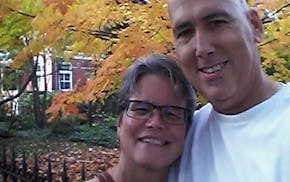Larpenteur Avenue cuts through Lauderdale and Falcon Heights, past fields of crops surrounded by modest but well-kept ranch homes, past the University of Minnesota campus and golf course and the state's most iconic venue, the State Fairgrounds.
Those public lands, nontaxable, occupy two-thirds of Falcon Heights.
Larpenteur is also a well-known speed trap, even getting mention on a website that shares those locations with cautious motorists. According to its annual report, the St. Anthony Police Department, which patrols the area, issued more than 4,300 citations in Falcon Heights and neighboring Lauderdale in 2015, though it generated only a small percentage of Falcon Heights' budget. The rigorous traffic monitoring also was geared to "suppressing and deterring criminal activities," according to the department's 2015 report.
For 30 years, it worked beautifully.
Then a young black man with dreadlocks, Philando Castile, passed through town. He had a shockingly long list of misdemeanors and petty misdemeanors such as parking violations, not wearing a seat belt and driving without proof of insurance. Many of those violations going back to 2002 were dropped.
In other words, Castile had been stopped dozens of times over the past 14 years for minor or nonexistent violations because he was either a terrible driver or because he was singled out.
His last stop by police, ostensibly for a broken car light, cost him his life and created an international uproar over whether police too often use unnecessary force against black men.
Myron Orfield has studied racial segregation and said the number of times Castile was stopped seems unusually high, especially considering many violations were not readily visible to a passing officer. But it is consistent with the findings in his 2003 study of racial profiling, requested by state lawmakers.
It's an old study, but Orfield doesn't believe much, if anything, has been done about it. He thinks the study is probably still accurate because other studies of racial profiling for mortgage loans and "steering" potential homeowners from certain neighborhoods show the same results, if not worse.
"We have become really segmented, really fast," Orfield said.
The 2003 study found that blacks were stopped 310 percent more often than expected in Twin Cities suburbs.
"In particular, when we had a very white community next to a community with more diversity, we tended to have a very high number of stops," Orfield said.
Several studies nationally have confirmed that blacks are stopped at a higher rate than nonblacks, but most of those studies struggled to prove whether it was due to discrimination.
Orfield has also extensively studied open enrollment in schools. St. Anthony, where the officers who stopped Castile worked, was 84 percent white, compared with Minneapolis and St. Paul, which are both approximately 75 percent nonwhite. Most of the neighboring suburban school districts were 30 to 80 percent nonwhite, Orfield said. "St. Anthony actually became whiter through open enrollment, which is unusual."
None of which proves race was instrumental in the stopping and death of Castile, just that the confluence of factors made a ripe environment for the heartbreaking homicide.
"It's like the president said, we are asking police to man the barricades in neighborhoods that have lacked resources for years," said Orfield.
While he was shocked by the 2003 findings on profiling, "Whenever I talked to black people, they were never stunned," Orfield said. "We live in different worlds. People don't know each other."
John Reinan contributed to this column.
jtevlin@startribune.com • 612-673-1702
Follow Jon on Twitter: @jontevlin

Tevlin: 'Against all odds, I survived a career in journalism'

Tevlin: Grateful Frogtown couple fight their way back from fire and illness




